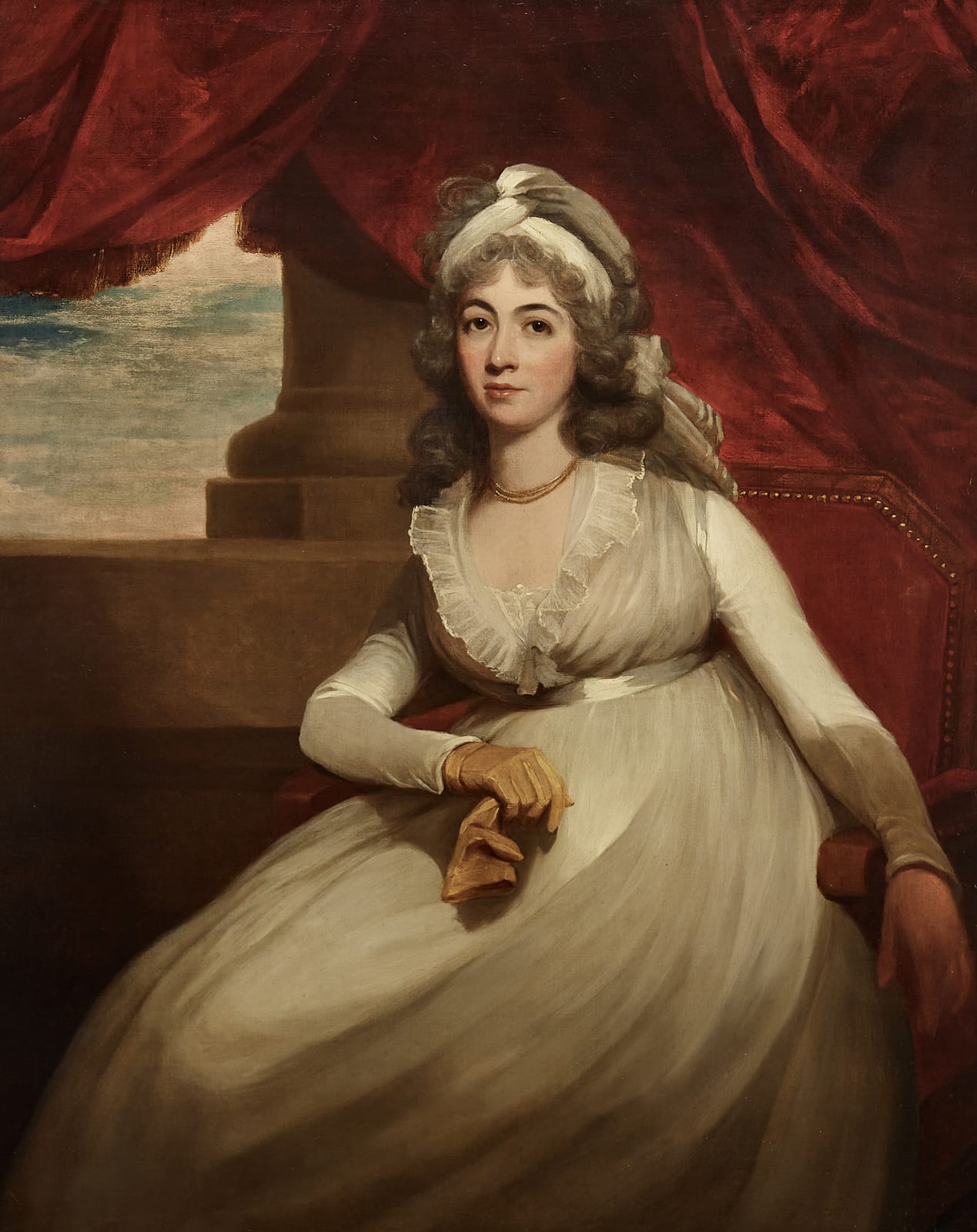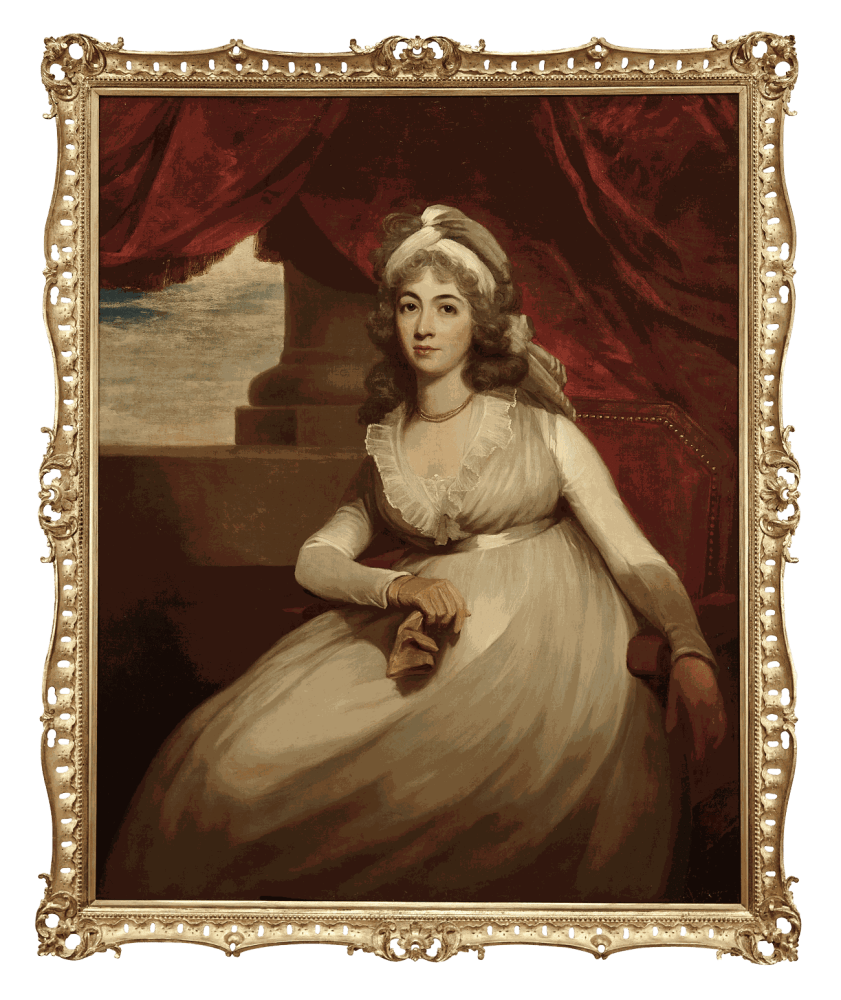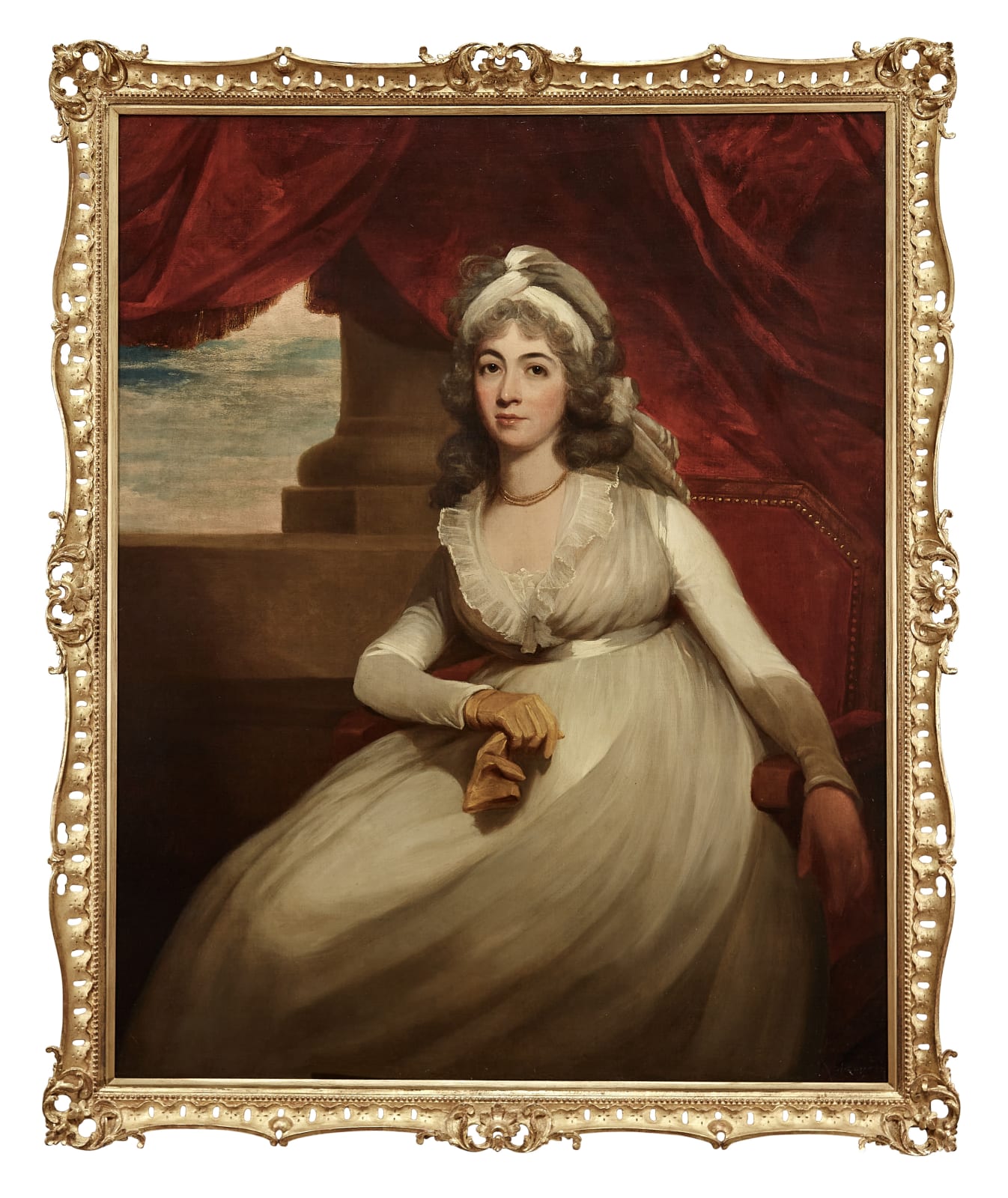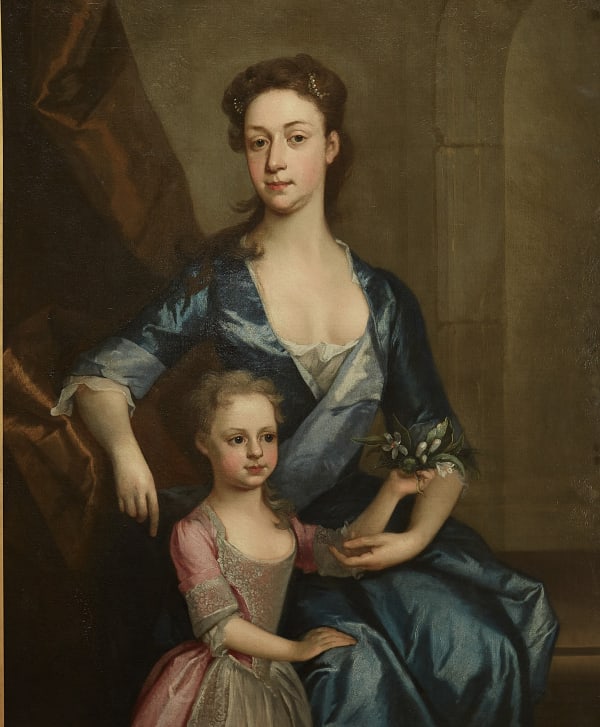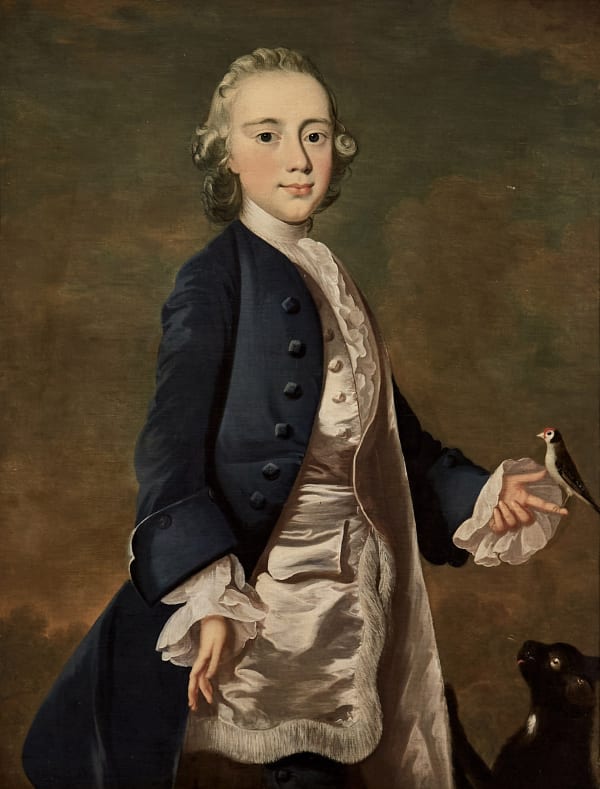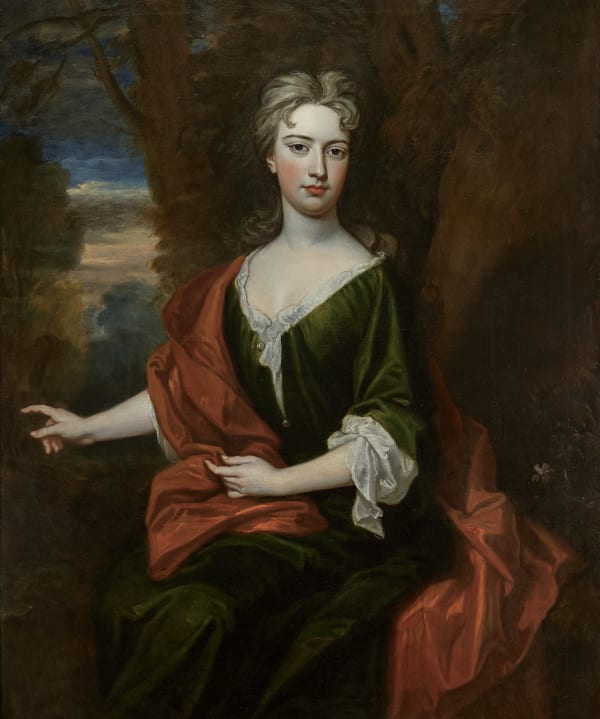Attributed to Sir Martin Archer Shee PRA (1769-1850)
Provenance
Edmund de Rothschild (1916-2009), Exbury House, Hampshire, UK
Sotheby's London, 4 September 1997, lot 35
Sotheby's London, 14 March 1990, lot 68
Old Hall Gallery Ltd, Iden, Rye, Sussex (according to label on reverse)
Sotheby's London, 28 November 1973, Mrs W. Woodward sale, lot 32 (as by John Hoppner), bought by 'Douglas'.
Literature
Kilburn, M. Henry Frederick, Prince, duke of Cumberland and Strathearn (1745–1790), Oxford Dictionary of National Biography, 2020
Ellis Waterhouse, The Dictionary of British 18th Century Painters, 1981.
Portrait of Anne, Duchess of Cumberland and Strathearn (1743-1808), three-quarter length, seated on a classical terrace in a white gown and headdress with yellow doeskin gloves.
Anne (née Luttrell; first married name Horton] Duchess of Cumberland and Strathearn (1743–1808), was born in Marylebone on 24 January 1743, the daughter of Simon Luttrell, Baron Irnham (1713–1787), and his wife, Judith Maria Lawes (d. 1798). Anne Luttrell's first husband was Christopher Horton (bap. 1741), the son of Christopher Horton and his wife, Frances, of Catton Hall, Derbyshire. They married on 4 August 1765, but Horton died on 5 August 1769.
Anne then married Henry Frederick, Prince, Duke of Cumberland and Strathearn, brother of George III on 2 October 1771, whom she had met at his Garter investiture ceremony at Windsor earlier that year. The Duke broke the news to George III on 2 November by presenting him with a letter announcing the marriage; the couple then departed for Calais. The marriage horrified George III, not only because of the Duchess's politically controversial family, but also because a marriage between a prince and a commoner was unequal in imperial law, barring any children from inheriting the electorate of Hanover. In Britain:
Cumberland refused to disavow the marriage and in consequence was barred from the king's presence. His mother, who was by now terminally ill, also refused to see him and they remained unreconciled at her death. Cumberland's failure to seek the King's permission for his marriage led to the King's forcing the Royal Marriages Act through parliament. It stipulated that no descendant of George II, other than the descendants of princesses who married into foreign families, could marry without the sovereign's consent.
Horace Walpole described the Duchess to Sir Horace Mann as 'Coquette beyond measure, artful as Cleopatra, and completely mistress of all her passions and projects' (Walpole, Corr., 23.345). It was probably her determination to be recognized as a princess that drove the couple forward, whereas the Duke was more relaxed about his social status. Excluded from the court of George III, the Cumberlands established a rival centre at Cumberland House in Pall Mall, which Cumberland acquired from the duke of Gloucester in 1772. They staged lavish entertainments, patronized musicians, had a succession of portraits painted, and travelled conspicuously in their state coach. Cumberland was still living on his original financial settlement and, beset by debts, the couple spent the period from summer 1773 to summer 1774 travelling in France and Italy. To the frustration of British diplomats attempting to execute George III's instructions that the Cumberlands should be allowed no precedence, the Duchess's claims to royal status were enhanced when she was received privately by Empress Maria Theresa at Vienna.
On their return to Britain the Duke and Duchess renewed their attempt to provide a livelier alternative to the court of George III. In 1775 Cumberland became patron of a boat club, the Cumberland Fleet, giving the Duke and Duchess the opportunity to sail down the Thames in a barge flying the royal standard at the centre of a well-attended social occasion. The society evolved into the Royal Thames Yacht Club. In the navy, the Duke was promoted to admiral in 1778, but was forbidden to assume a command. In summer 1779, suffering from ulcers on his lungs, he moved to Brighthelmstone (Brighton), Sussex, which he had first visited in September 1771. Cumberland was the first member of the royal family seriously to patronize the emerging spa and he later introduced the place to his nephew George, Prince of Wales.
Cumberland was reconciled to George III in 1780 after offering his services to the King in the face of the Gordon riots. However, the relationship between George III and his youngest surviving brother remained uneasy, mainly as a result of the growing friendship between the Cumberlands and the Prince of Wales. The Prince always insisted that Cumberland was a restraining influence on his impulsive character. Cumberland's health continued its gentle decline, and it was as much because of this as their poor finances that the Duke and Duchess spent almost all the period from November 1783 to October 1786 on the continent. They returned to London for about six weeks in October and November 1785 to advise the Prince of Wales, whose invalid marriage to Maria Fitzherbert they subsequently supported. They made a more permanent return in autumn 1786 on the advice of the Prince of Wales's surgeon, Sir Gilbert Blane, who had treated Cumberland. The Duke retained the role of a favourite uncle for the Prince of Wales, and in 1787 served as an emissary from the Prince to Pitt's ministry during negotiations to clear the Prince's debts. Both the Cumberlands were active supporters of the Prince of Wales during the regency crisis, Cumberland writing to his nephew Prince William (later William IV) in the West Indies to ensure his support, and the Duchess attending Commons debates on the Regency Bill. Cumberland died outside Cumberland House, Pall Mall, after stepping down from his coach, on 18 September 1790. He and the Duchess had no children.
The Duchess of Cumberland was granted an annual allowance of £4000, which the Prince of Wales thought 'shabby' (Correspondence of George, Prince of Wales, 2.103). She raised additional funds by auctioning the Duke's music library—including manuscripts by Handel and Haydn—musical instruments, and books at Christies during February 1791. She at first remained on close terms with the Prince of Wales, but distance grew between them after it was reported in December 1794 that while a guest at Brighton Pavilion she had criticized the Prince for breaking with Maria Fitzherbert. Mounting debts led her to move out of Cumberland House in 1793. She transferred the lease to her bankers in 1800 and went into exile on the continent. She died at Gorizia, near Trieste, Venetia, on 28 December 1808.
Sir Martin Archer Shee, the only Irish President of the Royal Academy, was born in Dublin on 20 December 1769, into a family originally from Kilkenny which had subsequently moved to County Mayo. He was sent to school in Dublin and there developed his talent as a draughtsman, which subsequently became his hallmark. Shee entered the Dublin Society's Drawing Schools in 1781, at the age of twelve, where under the tutelage of Francis Robert West he won virtually all the medals and prizes for which he was entered, notably the medal for landscape (1782) and portraiture (1783). At the age of 16 or 17, he set up his own studio at 32 Dame Street, Dublin, and, by 1786, was as busy as anyone with one head and two hands can possibly be .. I have pictures in hand to the amount of more than 50 guineas ..I am also to receive a silver palette from the Dublin Society in token of the approbation of my pictures.
Encouraged by Gilbert Stuart, the American painter then working in Ireland, in June 1788 he moved to England, working initially as a copyist for the engravers Macklin and Boydell. He was subsequently introduced to Sir Joshua Reynolds, who advised him to join the Royal Academy Schools, to which he was admitted in November 1790, just before his 21st birthday, and by the following year he was showing the first of his very many exhibits at the Royal Academy Summer Exhibitions. He was admitted an Associate of the Academy in 1798 and from then onwards his career was that of the hugely successful portrait painter, especially when, after the death of Sir Thomas Lawrence in 1830, he was elected by a large majority as President of the Royal Academy; in the same year he was knighted. Shee was a member of the Society of Dilettanti, the Royal Society and several overseas cultural institutes and academies. As well as painting, he was a poet, critic, and playwright. He died at Brighton on 19th August 1850.
-

-
 Attributed to Joseph Highmore (1692-1780)Portrait of a Lady and her Daughter, c.1720Oil on canvas146 x 121cm (57 1/2 x 47 1/2in.)£16,000.00%3Cdiv%20class%3D%22artist%22%3EAttributed%20to%20Joseph%20Highmore%20%20%281692-1780%29%3C/div%3E%3Cdiv%20class%3D%22title_and_year%22%3E%3Cspan%20class%3D%22title_and_year_title%22%3E%20Portrait%20of%20a%20Lady%20and%20her%20Daughter%3C/span%3E%2C%20%3Cspan%20class%3D%22title_and_year_year%22%3Ec.1720%3C/span%3E%3C/div%3E%3Cdiv%20class%3D%22medium%22%3EOil%20on%20canvas%3C/div%3E%3Cdiv%20class%3D%22dimensions%22%3E%20146%20x%20121cm%20%2857%201/2%20x%2047%201/2in.%29%3C/div%3E%3Cspan%20class%3D%22price%22%3E%C2%A316%2C000.00%3C/span%3E
Attributed to Joseph Highmore (1692-1780)Portrait of a Lady and her Daughter, c.1720Oil on canvas146 x 121cm (57 1/2 x 47 1/2in.)£16,000.00%3Cdiv%20class%3D%22artist%22%3EAttributed%20to%20Joseph%20Highmore%20%20%281692-1780%29%3C/div%3E%3Cdiv%20class%3D%22title_and_year%22%3E%3Cspan%20class%3D%22title_and_year_title%22%3E%20Portrait%20of%20a%20Lady%20and%20her%20Daughter%3C/span%3E%2C%20%3Cspan%20class%3D%22title_and_year_year%22%3Ec.1720%3C/span%3E%3C/div%3E%3Cdiv%20class%3D%22medium%22%3EOil%20on%20canvas%3C/div%3E%3Cdiv%20class%3D%22dimensions%22%3E%20146%20x%20121cm%20%2857%201/2%20x%2047%201/2in.%29%3C/div%3E%3Cspan%20class%3D%22price%22%3E%C2%A316%2C000.00%3C/span%3E -
 George Romney (1734-1802)Captain John Stables, 1785Oil on canvas162 x 135cm (63 3/4 x 53in)Sold%3Cdiv%20class%3D%22artist%22%3EGeorge%20Romney%20%281734-1802%29%20%3C/div%3E%3Cdiv%20class%3D%22title_and_year%22%3E%3Cspan%20class%3D%22title_and_year_title%22%3ECaptain%20John%20Stables%3C/span%3E%2C%20%3Cspan%20class%3D%22title_and_year_year%22%3E1785%3C/span%3E%3C/div%3E%3Cdiv%20class%3D%22medium%22%3EOil%20on%20canvas%3C/div%3E%3Cdiv%20class%3D%22dimensions%22%3E162%20x%20135cm%20%2863%203/4%20x%2053in%29%3C/div%3E
George Romney (1734-1802)Captain John Stables, 1785Oil on canvas162 x 135cm (63 3/4 x 53in)Sold%3Cdiv%20class%3D%22artist%22%3EGeorge%20Romney%20%281734-1802%29%20%3C/div%3E%3Cdiv%20class%3D%22title_and_year%22%3E%3Cspan%20class%3D%22title_and_year_title%22%3ECaptain%20John%20Stables%3C/span%3E%2C%20%3Cspan%20class%3D%22title_and_year_year%22%3E1785%3C/span%3E%3C/div%3E%3Cdiv%20class%3D%22medium%22%3EOil%20on%20canvas%3C/div%3E%3Cdiv%20class%3D%22dimensions%22%3E162%20x%20135cm%20%2863%203/4%20x%2053in%29%3C/div%3E -
 Attributed to Frans Van Der Mijn (1719-1793)Master Wanley with his pet bullfinch and cat, c.1760Oil on canvas107 x 87cm (42 x 34 1/4in)Sold%3Cdiv%20class%3D%22artist%22%3EAttributed%20to%20Frans%20Van%20Der%20Mijn%20%281719-1793%29%3C/div%3E%3Cdiv%20class%3D%22title_and_year%22%3E%3Cspan%20class%3D%22title_and_year_title%22%3EMaster%20Wanley%20with%20his%20pet%20bullfinch%20and%20cat%3C/span%3E%2C%20%3Cspan%20class%3D%22title_and_year_year%22%3Ec.1760%3C/span%3E%3C/div%3E%3Cdiv%20class%3D%22medium%22%3EOil%20on%20canvas%3C/div%3E%3Cdiv%20class%3D%22dimensions%22%3E107%20x%2087cm%20%2842%20x%2034%201/4in%29%3C/div%3E
Attributed to Frans Van Der Mijn (1719-1793)Master Wanley with his pet bullfinch and cat, c.1760Oil on canvas107 x 87cm (42 x 34 1/4in)Sold%3Cdiv%20class%3D%22artist%22%3EAttributed%20to%20Frans%20Van%20Der%20Mijn%20%281719-1793%29%3C/div%3E%3Cdiv%20class%3D%22title_and_year%22%3E%3Cspan%20class%3D%22title_and_year_title%22%3EMaster%20Wanley%20with%20his%20pet%20bullfinch%20and%20cat%3C/span%3E%2C%20%3Cspan%20class%3D%22title_and_year_year%22%3Ec.1760%3C/span%3E%3C/div%3E%3Cdiv%20class%3D%22medium%22%3EOil%20on%20canvas%3C/div%3E%3Cdiv%20class%3D%22dimensions%22%3E107%20x%2087cm%20%2842%20x%2034%201/4in%29%3C/div%3E -
 Christopher Steele (1733-1767)Giles Moore in his study reading the Iliad, c.1758Oil on canvas110 x 91cm (43¼ x 36in)Sold%3Cdiv%20class%3D%22artist%22%3EChristopher%20Steele%20%281733-1767%29%3C/div%3E%3Cdiv%20class%3D%22title_and_year%22%3E%3Cspan%20class%3D%22title_and_year_title%22%3EGiles%20Moore%20in%20his%20study%20reading%20the%20Iliad%3C/span%3E%2C%20%3Cspan%20class%3D%22title_and_year_year%22%3Ec.1758%3C/span%3E%3C/div%3E%3Cdiv%20class%3D%22medium%22%3EOil%20on%20canvas%3C/div%3E%3Cdiv%20class%3D%22dimensions%22%3E110%20x%2091cm%20%2843%C2%BC%20x%2036in%29%3C/div%3E
Christopher Steele (1733-1767)Giles Moore in his study reading the Iliad, c.1758Oil on canvas110 x 91cm (43¼ x 36in)Sold%3Cdiv%20class%3D%22artist%22%3EChristopher%20Steele%20%281733-1767%29%3C/div%3E%3Cdiv%20class%3D%22title_and_year%22%3E%3Cspan%20class%3D%22title_and_year_title%22%3EGiles%20Moore%20in%20his%20study%20reading%20the%20Iliad%3C/span%3E%2C%20%3Cspan%20class%3D%22title_and_year_year%22%3Ec.1758%3C/span%3E%3C/div%3E%3Cdiv%20class%3D%22medium%22%3EOil%20on%20canvas%3C/div%3E%3Cdiv%20class%3D%22dimensions%22%3E110%20x%2091cm%20%2843%C2%BC%20x%2036in%29%3C/div%3E -
 Charles Jervas (1675-1739)Henrietta Pelham-Holles, Duchess of Newcastle, c.1715Oil on canvas126 x 104cm (49 1/2 x 41in)£14,000.00%3Cdiv%20class%3D%22artist%22%3E%20Charles%20Jervas%20%281675-1739%29%3C/div%3E%3Cdiv%20class%3D%22title_and_year%22%3E%3Cspan%20class%3D%22title_and_year_title%22%3EHenrietta%20Pelham-Holles%2C%20Duchess%20of%20Newcastle%3C/span%3E%2C%20%3Cspan%20class%3D%22title_and_year_year%22%3Ec.1715%3C/span%3E%3C/div%3E%3Cdiv%20class%3D%22medium%22%3EOil%20on%20canvas%3C/div%3E%3Cdiv%20class%3D%22dimensions%22%3E126%20x%20%20104cm%20%2849%201/2%20x%2041in%29%3C/div%3E%3Cspan%20class%3D%22price%22%3E%C2%A314%2C000.00%3C/span%3E
Charles Jervas (1675-1739)Henrietta Pelham-Holles, Duchess of Newcastle, c.1715Oil on canvas126 x 104cm (49 1/2 x 41in)£14,000.00%3Cdiv%20class%3D%22artist%22%3E%20Charles%20Jervas%20%281675-1739%29%3C/div%3E%3Cdiv%20class%3D%22title_and_year%22%3E%3Cspan%20class%3D%22title_and_year_title%22%3EHenrietta%20Pelham-Holles%2C%20Duchess%20of%20Newcastle%3C/span%3E%2C%20%3Cspan%20class%3D%22title_and_year_year%22%3Ec.1715%3C/span%3E%3C/div%3E%3Cdiv%20class%3D%22medium%22%3EOil%20on%20canvas%3C/div%3E%3Cdiv%20class%3D%22dimensions%22%3E126%20x%20%20104cm%20%2849%201/2%20x%2041in%29%3C/div%3E%3Cspan%20class%3D%22price%22%3E%C2%A314%2C000.00%3C/span%3E -
 Godfrey Kneller (1646-1723)Portrait of a lady, wearing a green gown and red cloak in a landscape, c.1705Oil on canvas147 x 122cm (58 x 48in)Sold%3Cdiv%20class%3D%22artist%22%3EGodfrey%20Kneller%20%281646-1723%29%3C/div%3E%3Cdiv%20class%3D%22title_and_year%22%3E%3Cspan%20class%3D%22title_and_year_title%22%3EPortrait%20of%20a%20lady%2C%20wearing%20a%20green%20gown%20and%20red%20cloak%20in%20a%20landscape%3C/span%3E%2C%20%3Cspan%20class%3D%22title_and_year_year%22%3Ec.1705%3C/span%3E%3C/div%3E%3Cdiv%20class%3D%22medium%22%3EOil%20on%20canvas%3C/div%3E%3Cdiv%20class%3D%22dimensions%22%3E%20147%20x%20%20122cm%20%2858%20x%2048in%29%3C/div%3E
Godfrey Kneller (1646-1723)Portrait of a lady, wearing a green gown and red cloak in a landscape, c.1705Oil on canvas147 x 122cm (58 x 48in)Sold%3Cdiv%20class%3D%22artist%22%3EGodfrey%20Kneller%20%281646-1723%29%3C/div%3E%3Cdiv%20class%3D%22title_and_year%22%3E%3Cspan%20class%3D%22title_and_year_title%22%3EPortrait%20of%20a%20lady%2C%20wearing%20a%20green%20gown%20and%20red%20cloak%20in%20a%20landscape%3C/span%3E%2C%20%3Cspan%20class%3D%22title_and_year_year%22%3Ec.1705%3C/span%3E%3C/div%3E%3Cdiv%20class%3D%22medium%22%3EOil%20on%20canvas%3C/div%3E%3Cdiv%20class%3D%22dimensions%22%3E%20147%20x%20%20122cm%20%2858%20x%2048in%29%3C/div%3E -
 Thomas Hudson (1701-1799)Portrait of a young lady in a blue gown, c.1736Oil on canvas120 x 94cm (47 1/4 x 37in)Sold%3Cdiv%20class%3D%22artist%22%3EThomas%20Hudson%20%281701-1799%29%3C/div%3E%3Cdiv%20class%3D%22title_and_year%22%3E%3Cspan%20class%3D%22title_and_year_title%22%3EPortrait%20of%20a%20young%20lady%20in%20a%20blue%20gown%3C/span%3E%2C%20%3Cspan%20class%3D%22title_and_year_year%22%3Ec.1736%3C/span%3E%3C/div%3E%3Cdiv%20class%3D%22medium%22%3EOil%20on%20canvas%3C/div%3E%3Cdiv%20class%3D%22dimensions%22%3E%20120%20x%2094cm%20%2847%201/4%20x%2037in%29%3C/div%3E
Thomas Hudson (1701-1799)Portrait of a young lady in a blue gown, c.1736Oil on canvas120 x 94cm (47 1/4 x 37in)Sold%3Cdiv%20class%3D%22artist%22%3EThomas%20Hudson%20%281701-1799%29%3C/div%3E%3Cdiv%20class%3D%22title_and_year%22%3E%3Cspan%20class%3D%22title_and_year_title%22%3EPortrait%20of%20a%20young%20lady%20in%20a%20blue%20gown%3C/span%3E%2C%20%3Cspan%20class%3D%22title_and_year_year%22%3Ec.1736%3C/span%3E%3C/div%3E%3Cdiv%20class%3D%22medium%22%3EOil%20on%20canvas%3C/div%3E%3Cdiv%20class%3D%22dimensions%22%3E%20120%20x%2094cm%20%2847%201/4%20x%2037in%29%3C/div%3E
Join our mailing list
* denotes required fields
We will process the personal data you have supplied to communicate with you in accordance with our Privacy Policy. You can unsubscribe or change your preferences at any time by clicking the link in our emails.
Old master, British and European paintings and sculpture from the 16th To 19th century

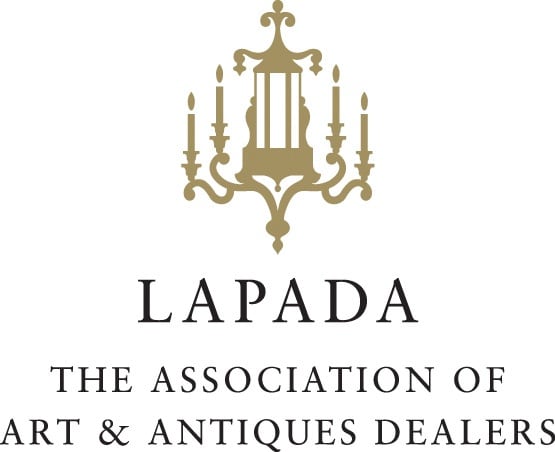
+44(0)7984 699799 CONTACT@ISHERWOODFINEART.COM
This website uses cookies
This site uses cookies to help make it more useful to you. Please contact us to find out more about our Cookie Policy.
